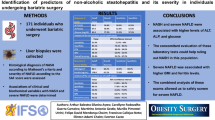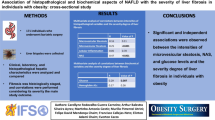Abstract
Background
Fibrotic non-alcoholic steatohepatitis (NASH), i.e., the concomitant presence of active inflammation and fibrosis, represents a milestone in the natural history of NAFLD and a critical time point in its progression. The purpose of this study was to analyze the diagnostic accuracy of the non-invasive Fibrotic NASH Index (FNI) in individuals with obesity undergoing bariatric surgery.
Methods
This is a cross-sectional study, enrolling individuals who underwent bariatric surgery with liver biopsy at a tertiary university hospital. FNI was calculated, and a cutoff value was determined. Its diagnostic accuracy was then calculated through comparison with the gold standard test for this analysis (histopathological examination).
Results
Of 128 participants, 83.6% were female, and the average age was 39.8 ± 8.7 years. The mean BMI was 38.7 ± 5.7 kg/m2. NAFLD was histologically confirmed in 76.6%, of which 81.6% had NASH. Histologically confirmed fibrotic NASH was observed in 22.7% of the general study population, 29.6% of individuals with NAFLD, and 36.3% of those with NASH. The mean FNI was 0.18 ± 0.19. An optimal cutoff point of 0.21 was determined, with an overall accuracy of 90.1%, an 82.8% sensitivity, a 90.8% specificity, a 72.6% positive predictive value, and a 94.7% negative predictive value.
Conclusions
FNI provided adequate accuracy in detecting and ruling out fibrotic NASH. Considering the importance of fibrotic NASH within the natural history of NAFLD progression and the fact that this marker uses simple variables, it may be of great importance in high-risk populations, and its external validation and use should be encouraged.
Graphical Abstract




Similar content being viewed by others
References
Ludwig J, Viggiano TR, McGill DB, et al. Nonalcoholic steatohepatitis: Mayo Clinic experiences with a hitherto unnamed disease. Mayo Clin Proc. 1980;55(7):434–8.
Sheth SG, Gordon FD, Chopra S. Nonalcoholic steatohepatitis. Ann Intern Med. 1997;126(2):137–45.
Williams CD, Stengel J, Asike MI, et al. Prevalence of nonalcoholic fatty liver disease and nonalcoholic steatohepatitis among a largely middle-aged population utilizing ultrasound and liver biopsy: a prospective study. Gastroenterology. 2011;140(1):124–31.
Lazo M, Hernaez R, Eberhardt MS, et al. Prevalence of nonalcoholic fatty liver disease in the United States: the Third National Health and Nutrition Examination Survey, 1988–1994. Am J Epidemiol. 2013;178(1):38–45.
Nobili V, Alisi A, Valenti L, et al. NAFLD in children: new genes, new diagnostic modalities and new drugs. Nat Rev Gastroenterol Hepatol. 2019;16(9):517–30.
Dongiovanni P, Stender S, Pietrelli A, et al. Causal relationship of hepatic fat with liver damage and insulin resistance in nonalcoholic fatty liver. J Intern Med. 2018;283(4):356–70.
Brunt EM, Kleiner DE, Carpenter DH, et al. American association for the study of liver diseases NASH task force. NAFLD: reporting histologic findings in clinical practice. Hepatology. 2021;73(5):2028–38.
Yeh MM, Brunt EM. Pathological features of fatty liver disease. Gastroenterology. 2014;147(4):754–64.
Germano CW, Mega PF, Mattosinho TJAP, et al. Microvesicular steatosis in individuals with obesity: a histological marker of non-alcoholic fatty liver disease severity. Obes Surg. 2023;33(3):813–20.
Cazzo E, Pareja JC, Chaim EA. Nonalcoholic fatty liver disease and bariatric surgery: a comprehensive review. Sao Paulo Med J. 2017;135(3):277–95.
Franck M, John K, Al Aoua S, et al. Hepatokine-based identification of fibrotic NASH and improved risk stratification in a multicentre cohort of NAFLD patients. Liver Int. 2023. https://doi.org/10.1111/liv.15686.
von Roenn N. Spotlight on impactful research: increased risk of mortality by fibrosis stage in nonalcoholic fatty liver disease: systemic review and meta-analysis. Clin Liver Dis. 2018;12(2):35–8 (Hoboken).
Concon MM, Gestic MA, Utrini MP, et al. Should routine liver biopsy be considered in bariatric surgical practice? An analysis of the limitations of non-invasive NAFLD markers. Arq Gastroenterol. 2022;59(1):110–6.
Ferraioli G, Soares Monteiro LB. Ultrasound-based techniques for the diagnosis of liver steatosis. World J Gastroenterol. 2019;25(40):6053–62.
Zhang YN, Fowler KJ, Hamilton G, et al. Liver fat imaging-a clinical overview of ultrasound, CT, and MR imaging. Br J Radiol. 2018;91(1089):20170959.
Kinner S, Reeder SB, Yokoo T. Quantitative imaging biomarkers of NAFLD. Dig Dis Sci. 2016;61(5):1337–47.
Loomba R. Role of imaging-based biomarkers in NAFLD: recent advances in clinical application and future research directions. J Hepatol. 2018;68(2):296–304.
Matteoni CA, Younossi ZM, Gramlich T. Nonalcoholic fatty liver disease: a spectrum of clinical and pathological severity. Gastroenterology. 1999;116(6):1413–9.
European Association for the Study of the Liver. EASL Clinical Practice Guidelines on non-invasive tests for evaluation of liver disease severity and prognosis - 2021 update. J Hepatol. 2021;75(3):659–89.
Tavaglione F, Jamialahmadi O, De Vincentis A, et al. Development and validation of a score for fibrotic nonalcoholic steatohepatitis. Clin Gastroenterol Hepatol. 2023;21(6):1523-1532.e1.
Sergeant ESG. Epitools epidemiological calculators [Internet]. Freemantle: Ausvet Pty Ltd. 2018. Available from: http://epitools.ausvet.com.au. Accessed 10 Sep 2023
John K, Franck M, Al Aoua S, et al. Non-invasive detection of fibrotic NASH in NAFLD patients with low or intermediate FIB-4. J Clin Med. 2022;11(15):4394.
Tacke F, Weiskirchen R. Non-alcoholic fatty liver disease (NAFLD)/non-alcoholic steatohepatitis (NASH)-related liver fibrosis: mechanisms, treatment and prevention. Ann Transl Med. 2020;9(8):729.
Dulai PS, Singh S, Patel J, et al. Increased risk of mortality by fibrosis stage in nonalcoholic fatty liver disease: systematic review and meta-analysis. Hepatology. 2017;65(5):1557–65.
Angulo P, Hui JM, Marchesini G, et al. The NAFLD fibrosis score: a noninvasive system that identifies liver fibrosis in patients with NAFLD. Hepatology. 2007;45(4):846–54.
Cichoż-Lach H, Celiński K, Prozorow-Król B, et al. The BARD score and the NAFLD fibrosis score in the assessment of advanced liver fibrosis in nonalcoholic fatty liver disease. Med Sci Monit. 2012;18(12):CR735-40.
Jimenez LS, Marques RA, Gestic MA, et al. Non-invasive markers in non-alcoholic fatty liver disease: reliability is variable according to BMI status. Obes Surg. 2021;31(8):3888–92.
Zhou H, Luo P, Li P, et al. Bariatric surgery improves nonalcoholic fatty liver disease: systematic review and meta-analysis. Obes Surg. 2022;32(6):1872–83.
Kreve F, Callejas GH, Jimenez LS, et al. Trajectory of NAFLD characteristics after Roux-en-Y gastric bypass: a five-year historical cohort study. Sao Paulo Med J. 2022;140(6):739–46.
Bower G, Toma T, Harling L, et al. Bariatric surgery and non-alcoholic fatty liver disease: a systematic review of liver biochemistry and histology. Obes Surg. 2015;25(12):2280–9.
Cazzo E, Jimenez LS, Pareja JC, et al. Effect of Roux-en-Y gastric bypass on nonalcoholic fatty liver disease evaluated through NAFLD fibrosis score: a prospective study. Obes Surg. 2015;25(6):982–5.
Ratziu V, Massard J, Charlotte F, et al. LIDO study group; CYTOL study group. Diagnostic value of biochemical markers (FibroTest-FibroSURE) for the prediction of liver fibrosis in patients with non-alcoholic fatty liver disease. BMC Gastroenterol. 2006;6:6.
Vali Y, Lee J, Boursier J, et al. Litmus systematic review team. FibroTest for evaluating fibrosis in non-alcoholic fatty liver disease patients: a systematic review and meta-analysis. J Clin Med. 2021;10(11):2415.
Selvaraj EA, Mózes FE, Jayaswal ANA, et al. LITMUS investigators. Diagnostic accuracy of elastography and magnetic resonance imaging in patients with NAFLD: a systematic review and meta-analysis. J Hepatol. 2021;75(4):770–85.
Author information
Authors and Affiliations
Corresponding author
Ethics declarations
Ethical Approval
All procedures performed in studies involving human participants were in accordance with the ethical standards of the institutional and/or national research committee and with the 1964 Helsinki declaration and its later amendments or comparable ethical standards.
Informed Consent
Informed consent was obtained from all individual participants included in the study.
Conflict of Interest
Luísa Souza Echeverria: no conflict of interest.
Daniel Leandro Saran Mounzer: no conflict of interest.
Martinho Antonio Gestic: no conflict of interest.
Murillo Pimentel Utrini: no conflict of interest.
Felipe David Mendonça Chaim: no conflict of interest.
Francisco Callejas-Neto: no conflict of interest.
Elinton Adami Chaim: no conflict of interest.
Everton Cazzo: no conflict of interest.
Additional information
Publisher's Note
Springer Nature remains neutral with regard to jurisdictional claims in published maps and institutional affiliations.
Rights and permissions
Springer Nature or its licensor (e.g. a society or other partner) holds exclusive rights to this article under a publishing agreement with the author(s) or other rightsholder(s); author self-archiving of the accepted manuscript version of this article is solely governed by the terms of such publishing agreement and applicable law.
About this article
Cite this article
de Souza Echeverria, L., Mounzer, D.L.S., Gestic, M.A. et al. Fibrotic NASH in Individuals with Obesity: a Cross-sectional Analysis of the Prevalence of this Significant Milestone of Disease Progression and Accuracy of a Non-invasive Marker for its Screening. OBES SURG 34, 389–395 (2024). https://doi.org/10.1007/s11695-023-06998-1
Received:
Revised:
Accepted:
Published:
Issue Date:
DOI: https://doi.org/10.1007/s11695-023-06998-1




